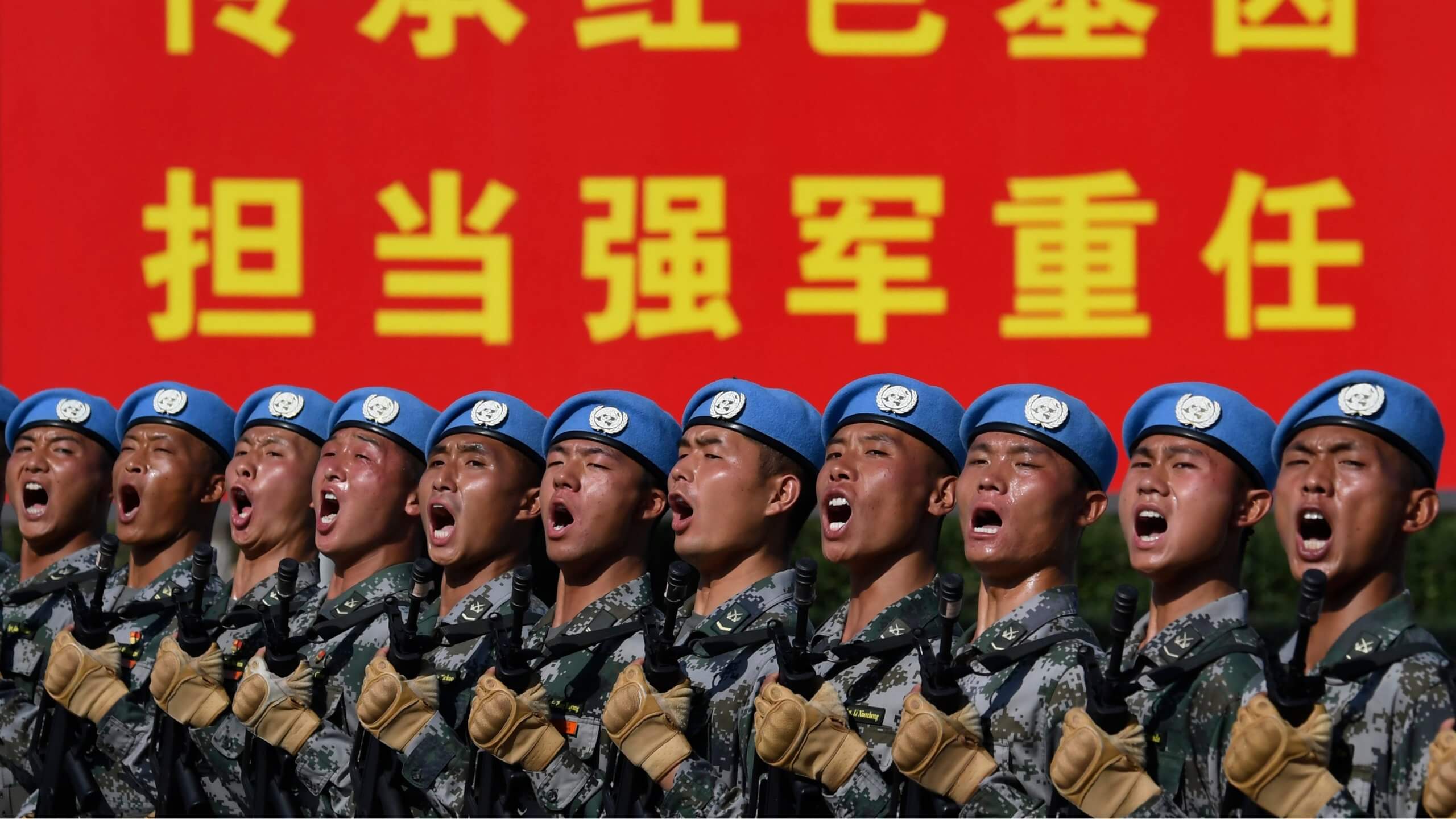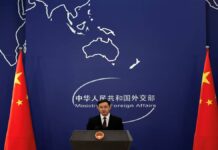HONG KONG: There is growing alarm at the inexorable rise of China, both of its military prowess and its aggressive bullying of other countries plus its subjugation of whole portions of its own population.
Under Chairman Xi Jinping, China has accelerated its militarization, with constant remonstrations for the People’s Liberation Army (PLA) to modernize and to boost its loyalty to the Chinese Communist Party (CCP). Ominously, Xi spends a lot of time telling the populace to prepare for an all-out “struggle”. At the same time, Xi has stamped his authority on every single aspect of Chinese society so as to control the thinking and behavior of his 1.4 billion subjects.
There is growing fear among China’s neighbors, and Western countries like the USA, that China will stoke a war. For now, the PLA is using “gray zone” tactics, behavior short of armed struggle but which is nonetheless coercive and bullying, to gain control of areas like the South China Sea. Last year, tensions boiled over into outright soldier-on-soldier violence along the border with India in Eastern Ladakh.
One American think-tank that has been particularly vocal about the China threat, especially to Taiwan, is the Project 2049 Institute based in Virginia. This organization held a webinar on 25 February entitled “The Five-Year Scan: Assessing PLA Reforms, Readiness and Potential Indo-Pacific Contingencies”.
The Project 2049 Institute’s guest speaker was Chad Sbragia, who until recently was Deputy Assistant Secretary of Defense for China in the Office of the Assistant Secretary of Defense for Indo-Pacific Security Affairs within the Office of the Secretary of Defense. He described the threat, saying, “More simply, the PLA isn’t preparing to fight today’s war better; they’re really preparing to prevail in future wars, wars that no country has fought or that has emerged yet in full form.”
Sbragia continued: “The heart of the PLA’s view of future warfighting was summed up nicely this week in yet another PLA article on future war design. To paraphrase the author, future war design is a pre-war craft that combines military science with what they refer to as futurology, in what the author describes as the grand chess game of world military competition. In order to seek the initiative in future wars, it is necessary to foresee and to scientifically design wars as soon as possible and to strive to find insights for future wars.” Indeed, the PLA believes that the form of war and its winning mechanism has changed, with constant talk about mechanized, intelligentized and informationized warfare.
Sbragia warned, “The PLA largely concludes that the era of steel hitting steel is past. Modern warfare will be a contest between systems … But what’s of real interest to me is the conceptual modernity of the reforms that are driving [PLA] strategy. I have real concern that we’re not keeping pace with that.”
With China investing so heavily in its military – though its defense spending does not come close to that of the USA – concern is rising. ANI asked panelists on the same Project 2049 Institute webinar whether war in the South China Sea or Taiwan was inevitable.
Mark Stokes, executive director of the Project 2049 Institute, replied: “Yes, heavy investment in the military does imply intent to use them, but that’s all part of deterrence to a large extent. I also think it’s useful to note that the PLA is a political army, a political-military establishment, which means it is very much under the control of the Chinese Communist Party.”
Stokes, a former lieutenant colonel in the US Air Force, said, “The role and function of the Political Warfare Department…is grossly underestimated. It’s not just a force for defense propaganda, not just a force for military security, but it’s also the primary instrument of Chinese political warfare or influence operations. We tend to look at the use of force in a binary sense: either you’re in a state of peace or at war, but I think historically from the PLA perspective there is no black or white, but rather a continuum of operations and it’s at a constant state of war.”
Also answering ANI, Kim Fassler, an analyst with the US Department of Defense, explained: “I think you have to look at the big strategic goals. For a very long time, China has felt that it needs to have a strong military commensurate with its international status. So I think you can do a lot of things with a large and powerful and global military that are not essentially fighting in a conflict. One of those things that I mentioned is deterrence, better deterrence of other regional actors or even the United States, that are trying to take things that you believe belong to you. So I think that there are many applications for a fully modernized world-class military besides using them for a kinetic conflict.”
Tomohiko Taniguchi, Professor at the Graduate School of SDM, Keio University in Tokyo, and a former special advisor to the Cabinet of Prime Minister Shinzo Abe, added his perspective: “One way to understand why the Chinese are doing what they’re doing is to remind us that China is unique, in the sense that it is standing alone, supported by no-one else. China does not have an alliance partner. You could say Pakistan, North Korea are alliance partners, but there are more on the receiving end than the giving end, so China must protect its stakes alone, by itself. That distinguishes China from countries like Japan and Australia. For Japan and Australia, trading between the two nations has gone on without considering any threat until very much recently because the Pacific Ocean was the ‘American lake’.”
Taniguchi added, “But not for China, China is trading heavily with Peru and Chile, and that’s the longest sea lane of trade on the surface of the globe; they are operating basically in the enemy’s territory, which is the reason why they have to colonize Fiji, for instance. Fiji stands right in the middle, midway between Shanghai and Peru and Chile. One always has to remember that China feels very much alone by itself. And if you add the long-standing sentiment that China is an injured animal, humiliated by many others, the final straw coming from Japan, one must also remember those psychological elements as well.”
Fassmer also addressed the speed of PLA modernization. “In 2017 at the 19th Party Congress there were a number of goals for the PLA that were announced, and one was by mid-century building a world-class military, and by 2035 basically completing military modernization. So some people see this interim announcement of the 2035 goal as accelerating the PLA’s modernization. In the 1990s, Jiang Zemin issued a three-step plan that would have achieved the goal of basic military modernization by the mid-century, but pushing that goal up to 2035 in a way is seen as an acceleration of it. I think regardless of how you do it, it does reflect China’s confidence in doubling down in that the things they are doing are going fairly well. There’s a sense of confidence in Beijing…”
It was Deng Xiao-ping who introduced a new economic policy called “socialism with Chinese characteristics”, as he sought to salvage China from the wreckage of Mao Zedong’s experiments that plunged the country into chaos and starvation. Xi has run with this “Chinese socialism” and in fact taken it to the extreme. Alarmingly, China has become totalitarian under Xi.
Zbigniew Brzezinski, a Polish-American diplomat and political scientist who was once a counselor to President Lyndon B. Johnson from 1966-68, listed six characteristics of a totalitarian state. These are: party control of the military, official ideology, a single political party deliberately led by one man, secret police, party control of mass communications and a central-directed economy.
China soundly ticks the boxes for all six traits. Starting with the military aspect, the PLA is the armed wing of the CCP. It is not a national army, but one loyal purely to the party. China has the second highest defense budget in the world behind only the USA. As Mao said, “Political power grows out of the barrel of a gun,” so Xi is making sure the PLA has the largest gun possible.
What about ideology? At the National Party Congress of 2017, Xi Jinping Thought for the New Era of Socialism with Chinese Special Characteristics was promulgated, elevating Xi to the pantheon of Mao and Deng. Ideology underpins everything, with the indoctrination beginning in one’s infancy.
Does one man lead a single party in China? Definitely! Since assuming power, Xi has worked tirelessly to eliminate opponents and potential threats, often through his anti-corruption campaign. This is fairly easy to do since corruption is endemic anyway. Xi dominates state news and his portrait is commonplace, even on church walls now. Such is his power that Xi abolished any time limits on his rule, meaning that he can remain on Beijing’s throne until he dies. In the vote pushing this through, 2,958 voted for it – just two opposed and three abstained.
The CCP holds all the power. While China likes to pay lip service to a pluralistic political system where competing political parties exist, this is nonsense as these alternatives exist only as props in the CCP’s charade.
How about secret police? China is controlled by strict surveillance, with cameras identifying vehicles and people via facial recognition. The Ministries of Public Security and State Security have unfettered powers to detain, arrest and disappear any they wish. These agencies now have authority to operate freely in Hong Kong too. Prisons and labor camps are full of dissenters and “opponents of the state”. The legal system and courts are controlled by the CCP. Horrifically, Beijing is targeting whole religions and ethnic groups, with at least a million Uyghurs interred without trial in concentration camp conditions in Xinjiang.
The next trait is control of communications. True in China? Totally. The CCP ensures newspapers, magazines, television and the internet do its bidding, often through self-censorship. China’s Great Firewall prevents citizens from accessing overseas websites, and a social credit system forces full compliance so that every aspect of life is controlled by the government. Historical events such as the Tiananmen Square Massacre are invisible, banned from Chinese textbooks and internet.
Social media such as WeChat or Sino Weibo are tightly monitored, while foreign platforms like Facebook, Google and Twitter are banned. More than that, the CCP is working very hard – and succeeding – to manipulate Western media to tell its whitewashed version of events.
The final characteristic is a centrally controlled economy. Business has boomed in China, creating thousands of millionaires and even billionaires, including people like Jack Ma. However, when such people grow too powerful, the CCP is quick to cut them down to size, as it has done with Ma.
Some might argue that China’s economy is authoritarian rather than totalitarian. Yes, private business exists, but it is only by the permission of the CCP. Furthermore, every business is legally required to pass over any data that the CCP desires. There are more than 51,000 state-owned enterprises (SOE) in China, and nearly all its 500 top companies are SOEs. It is the CCP that makes all decisions about the market, and Xi has centralized things even more.
The US government describes China as an authoritarian state, as do non-governmental organizations like Human Rights Watch. But perhaps it is high time to update the terminology and label Xi’s China as it truly is, totalitarian and militaristic. (ANI)







